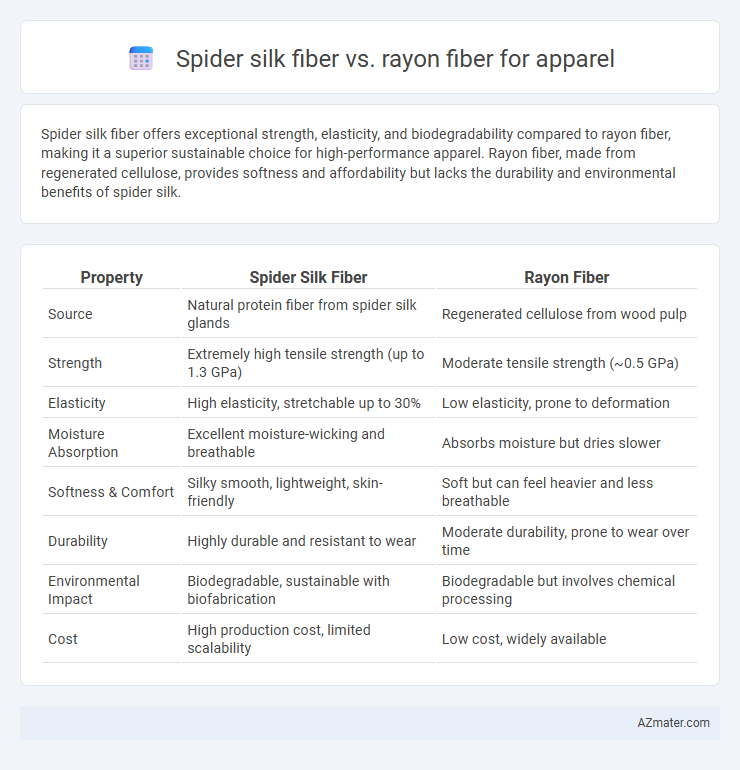Spider silk fiber offers exceptional strength, elasticity, and biodegradability compared to rayon fiber, making it a superior sustainable choice for high-performance apparel. Rayon fiber, made from regenerated cellulose, provides softness and affordability but lacks the durability and environmental benefits of spider silk.
Table of Comparison
| Property | Spider Silk Fiber | Rayon Fiber |
|---|---|---|
| Source | Natural protein fiber from spider silk glands | Regenerated cellulose from wood pulp |
| Strength | Extremely high tensile strength (up to 1.3 GPa) | Moderate tensile strength (~0.5 GPa) |
| Elasticity | High elasticity, stretchable up to 30% | Low elasticity, prone to deformation |
| Moisture Absorption | Excellent moisture-wicking and breathable | Absorbs moisture but dries slower |
| Softness & Comfort | Silky smooth, lightweight, skin-friendly | Soft but can feel heavier and less breathable |
| Durability | Highly durable and resistant to wear | Moderate durability, prone to wear over time |
| Environmental Impact | Biodegradable, sustainable with biofabrication | Biodegradable but involves chemical processing |
| Cost | High production cost, limited scalability | Low cost, widely available |
Introduction to Spider Silk and Rayon Fibers
Spider silk fiber, a natural protein fiber produced by spiders, is renowned for its exceptional strength, elasticity, and biodegradability, making it a sustainable and innovative choice in apparel manufacturing. Rayon fiber, derived from regenerated cellulose, offers a soft texture and excellent breathability, widely used in fashion for its affordability and versatility. Comparing these fibers highlights spider silk's superior mechanical properties and eco-friendliness against rayon's cost-effectiveness and comfort in textile applications.
Origins and Production Processes
Spider silk fiber originates from the natural protein secretion of spiders and is harvested either through bioengineering or spider farming, making it a highly sustainable and renewable material. Rayon fiber is a semi-synthetic cellulose fiber derived from wood pulp that undergoes chemical treatments and regeneration processes in factories to create a versatile textile. Production of spider silk involves complex biotechnological methods for protein extraction and fiber spinning, whereas rayon production relies on industrial-scale chemical processing and mechanical drawing.
Chemical Structure and Composition
Spider silk fiber consists primarily of protein-based fibroin with repetitive sequences of amino acids such as glycine, alanine, and serine, giving it remarkable tensile strength and elasticity. Rayon fiber, derived from regenerated cellulose, is composed of linear chains of b-D-glucose units linked by b-1,4-glycosidic bonds, resulting in a cellulose-based polymer with moderate strength and high absorbency. The proteinaceous nature of spider silk provides superior mechanical properties and biodegradability compared to the polysaccharide structure of rayon, which influences moisture retention and dye affinity in apparel applications.
Mechanical Strength and Durability
Spider silk fiber exhibits superior mechanical strength compared to rayon fiber, boasting tensile strength up to 1.1 GPa and exceptional elasticity that allows it to absorb energy without breaking. Rayon fiber, derived from cellulose, has lower tensile strength, typically around 0.4-0.6 GPa, and lacks the resilience and abrasion resistance needed for long-lasting apparel. The durability of spider silk fiber surpasses rayon due to its natural protein structure, providing enhanced resistance to wear, tear, and environmental stress, making it ideal for high-performance and sustainable clothing applications.
Comfort and Wearability in Apparel
Spider silk fiber offers exceptional comfort and wearability in apparel due to its lightweight, breathable, and hypoallergenic properties, outperforming rayon fiber which tends to retain moisture and can cause discomfort in prolonged wear. The natural elasticity and strength of spider silk provide a smooth, flexible fit that adapts to body movements without losing shape, whereas rayon fibers are less durable and prone to wrinkling, affecting garment longevity. Spider silk's superior moisture-wicking capability ensures dryness and temperature regulation, making it ideal for active and everyday wear compared to rayon's limited breathability and slower drying time.
Moisture Management and Breathability
Spider silk fiber offers exceptional moisture management through its natural ability to wick sweat away from the skin, maintaining dryness and comfort during wear. Its superior breathability stems from a highly porous microstructure that facilitates efficient air circulation compared to rayon fiber, which tends to retain moisture due to its semi-synthetic cellulose base. The advanced moisture control and enhanced ventilation of spider silk make it an ideal choice for high-performance and sustainable apparel applications.
Biodegradability and Environmental Impact
Spider silk fiber exhibits superior biodegradability compared to rayon fiber, breaking down naturally without releasing harmful chemicals into the environment. Rayon production involves extensive chemical processing and deforestation, contributing significantly to environmental pollution and carbon emissions. Choosing spider silk fiber for apparel aligns with sustainable fashion goals by minimizing ecological footprint and promoting renewable, non-toxic materials.
Dyeability and Aesthetic Properties
Spider silk fiber exhibits superior dyeability due to its natural protein structure, allowing vibrant, long-lasting colors with excellent colorfastness compared to rayon fiber. Its unique luster and smooth texture provide an appealing aesthetic, creating luxurious, high-end apparel with a natural sheen that rayon, derived from cellulose, often lacks. Rayon fiber tends to have a more matte finish and may show uneven dye uptake, resulting in less vivid hues and a less refined appearance overall.
Cost and Scalability of Fabric Production
Spider silk fiber offers exceptional strength and elasticity but remains costly and limited in scalable production due to complex spider farming or synthetic biospinning techniques. Rayon fiber, derived from cellulose, provides an affordable and widely scalable fabric production method, supporting mass apparel manufacturing with consistent quality. Despite higher expenses, spider silk's sustainability and performance benefits are driving research toward improving its cost efficiency and industrial scalability.
Future Prospects in Apparel Industry
Spider silk fiber exhibits remarkable tensile strength, biodegradability, and elasticity, offering sustainable alternatives for high-performance apparel. Rayon fiber, derived from cellulose, is cost-effective and widely used but lacks the advanced mechanical properties and environmental benefits of spider silk. The future apparel industry is poised to embrace spider silk for innovative, eco-friendly textiles that meet growing demands for durability and sustainability.

Infographic: Spider silk fiber vs Rayon fiber for Apparel
 azmater.com
azmater.com